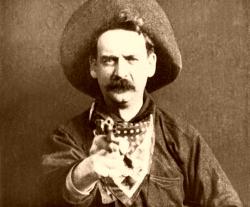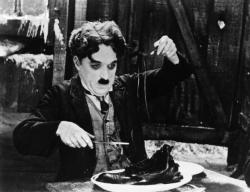Article
Silent Movie Tribute
Written by Patrick
First Posted: March 4th, 2001

A shot from 1903's The Great Train Robbery.
The birth of the art form known as The Motion Picture Industry occurred during the closing decade of the 19th Century, the Gilded Age. Technology was then changing the face of the world very rapidly. The inventions of photography, sound recording, the rise of the automobile, the telephone and the electric light were all either new or just becoming commonplace.
At first movies were really just short moving 'snap shots' of actual events. During the first decade of the 20th Century movies began having narratives. A Trip to the Moon (1902) and The Great Train Robbery (1903) were the first true movies. By 1914 the booming picture business had discovered its kingdom in a small farming community in southern California. A place called Hollywood.
Films then were usually short one or two-reelers, which fell into the western or action category, the romantic or historic genre, or were slapstick comedies. The latter being easily the most successful and enduring of all the silent film genres. Most people today know who Charlie Chaplin, Buster Keaton and Harold Lloyd are. Mack Sennett's famous Keystone Cops who introduced the classic comic art of pie throwing were perhaps the first successful film comedians. It was also Sennett who helped launch the careers of Chaplin as well as Mabel Normand, who, though almost forgotten today, was the first and greatest silent screen comedienne.
The two greatest and most well known directors from the silent era are undoubtedly, D. W. Griffith and Cecil B. DeMille. Griffith's Birth of a Nation and Intolerance, released in 1915 and 1916 respectively, are considered to be two of the first true film masterpieces and in fact it was Griffith who, between 1906 and 1916 almost single-handedly created the art of screen narrative. DeMille, was the ultimate showman, with him larger meant better. He directed the spectacular the Ten Commandments in 1923 and had huge sets built. He would remake the film himself more than thirty years later.

Charlie Chaplin in The Gold Rush.
Other enduring stars from the silent period include Mary Pickford, America's sweetheart; Douglas Fairbanks, the first screen Zorro; Gloria Swanson, who made many bedroom dramas with DeMille; Rudolph Valentino, The Sheik himself who was perhaps the first cult movie star as a result of dying young; Clara Bow, the original IT girl and the movies' most famous flapper; and western stars Tom Mix and William S. Hart. These names have endured and are still known today; others that are not as well remembered include Florence Lawrence, Alla Nazimova, Wallace Reid, Norma Talmadge, Pola Negri, Louise Lovely, Theda Bara, Chester Conklin, Natacha Rambova, Ramon Novarro, Nita Naldi, Conrad Nagel, Vilma Banky and Rod La Rocque.
Yes it was a time of excess and indulgence, when stars were making twenty thousand dollars a week with no income tax. When it was not uncommon for a starlet to have her hair dyed the same color as her pair of matching Russian wolfhounds. The naive public believed their favorite stars to be just like they appeared on screen, a royal class to be set apart and worshipped. Though this era of Hollywood started to crumble when Al Jolson sang Mammy in The Jazz Singer and then died completely with the stock market crash of 1929, it lives today on celluloid. If you have never really watched a silent film I recommend that you do so, they are dramatic, and larger than life, as movies should be.
